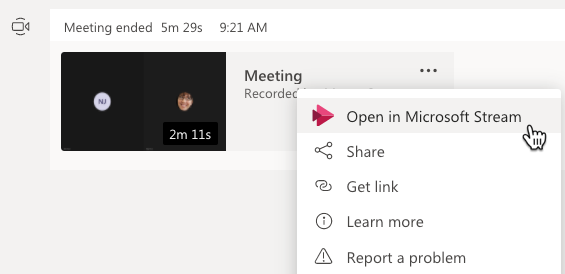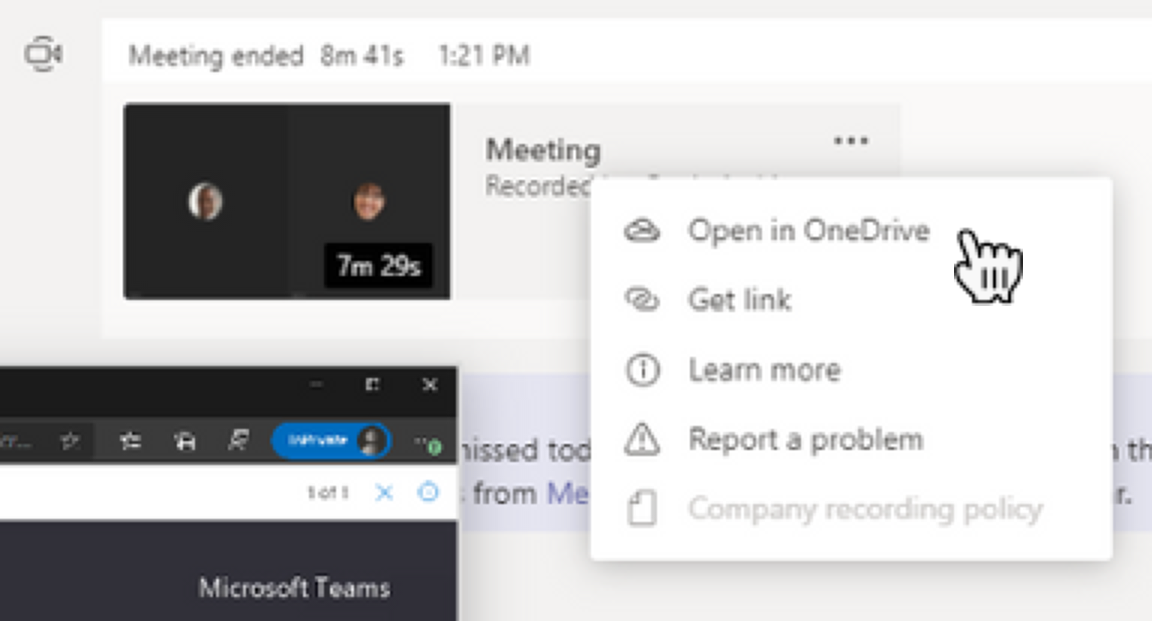Send that meeting recording to the people who need it
Important note: Microsoft announced on October 7 that they are delaying this feature rollout. Originally slated to be available on October 5, it's now pushed out to October 19, 2020.
Today’s post is going to cover how to share a MicrosoftTeams meeting recording with the people who were invited to or attended your meeting, even if they aren’t a part of your organization. For a video version of this post, click play below.
The value of recording a meeting
It can be really handy to record a Teams meeting. The recording can be useful for people who missed the meeting to catch up on everything that was discussed or it can act as multimedia minutes for later reference or maybe it’s a training session that can be relevant for literally years to come.
Because recordings come with transcriptions, the video is also searchable, which means you can jump quickly to the part of a meeting where keywords or phrases were used, even seeing who said what with speaker attribution.
The meeting recordings are automatically created by Microsoft Stream, Office 365’s internal YouTube-like video service. When you hold an internal meeting, the recording is made available to all attendees via the meeting chat. All they have to do is click the recording and it’ll open up and start playing.
But when you have a meeting with external people, the meeting recording won’t automatically be accessible to them after the meeting. Sure, they can still access the meeting chat after the meeting and they can click the meeting recording link that Stream leaves in the chat. But they’ll get hit with a permissions error if they try to open it. So you need to share that file with them so they have access to it.
As of today—the day this video was published in October 2020—Teams meeting recordings can now be stored in SharePoint and OneDrive, just like any other file. So if you know how to share a file from OneDrive, you know how to share a meeting recording now too. But your IT administrator needs to enable that feature. For the last couple years, we’ve had to use a workaround for sharing Teams meeting recordings, including downloading the file and sharing it from another storage location. So let’s cover step-by-step how to do both methods since it may take a while for everyone to get on the new Stream setup.
The new way: share using OneDrive and SharePoint
The new Stream experience has been upgraded to save all meeting recordings in SharePoint and OneDrive. This is a major improvement because you get all the benefits those tools provide, including external sharing, retention policies, labels, and other advanced security features you may have no idea even exist. It’s the external sharing that’s the big one.
But first, to even start saving recordings to OneDrive and SharePoint, your Office 365 administrator needs to enable meeting recordings to save automatically to SharePoint and OneDrive. You can tell if this is enabled by clicking the ellipsis menu next to a meeting recording created on or after October 5, 2020 and checking the menu option. If the menu still says “open in Microsoft Stream”, you’re not using SharePoint and OneDrive yet. If you don’t have a meeting recording to test, just give a colleague a quick video call, click the ellipses in the meeting toolbar and press record and leave recording on for a few seconds, then hang up. Stream will let you know when the recording is ready in the chat between you and that person.

If your system is still running the old setup, using Microsoft Stream’s portal to store the videos, it means your Office 365 administrator needs to run this PowerShell command to make the change. For organizations that work regularly with external people and run into the issue of sharing externally, consider enabling this sooner rather than later. However, if you work at a more inward-facing org (maybe insurance, a school), this feature may not be as useful because you lose the automatic connection of captions to the video with OneDrive and SharePoint. That said, the feature starts out as an opt-in feature, will then become an opt-out feature, and eventually everyone will be on it. So you need to be ready for it regardless.
Once the new Stream-storing feature is enabled, every meeting recording will be stored in SharePoint or OneDrive. Let’s cover the situations and the inherent permissions.

For channel meetings, the recording will be stored in a folder called Recordings in the Files tab. So this is when SharePoint comes in. Actually, it’s the only time SharePoint comes in. Everyone in the meeting will have access to the video file since they’re already all members of the Team. The permissions are pretty simple because the permissions are the permissions of the Team itself.
For scheduled meetings, meet now meetings, and any video or audio calls (which are basically just meet now meetings in a different context, right?), the recording will be stored in a folder called Recordings in the OneDrive of whoever clicks record.

Did you catch that? It doesn’t matter who starts the call or scheduled the meeting. It all comes down to who hits record. Which means moving forward, the task of hitting record matters. So be careful about who does it.
Once the meeting is over or the recording has been stopped, Stream will compile the video file and share it in the meeting chat, like it always has. Except now if you click on it, it doesn’t open up in Stream, it opens in OneDrive. Which, actually, this is a minor downside because playing videos in OneDrive is rather clunky. You also lose the interactive aspects like comments, likes, and whatnot.
Now, when it comes to permissions, the person who clicks record automatically has edit access to the video, which makes sense. If it was a scheduled meeting, the organizer will also have edit permissions to that video, in the other person’s OneDrive. And anyone else from the organization that was invited to the meeting can view the file.
However, guests and external attendees have no access to the meeting recording. They can still click the link in the meeting chat and they’ll receive an access denied error. From here they can request access and the recording owner will receive a request to allow access. Or the recording owner can be proactive and change the file permissions in OneDrive by adding the email address of anyone who was invited to the meeting or, if the meeting was huge, even changing the permissions to Anyone with the link can view.
So in essence, meeting recordings are acting very similarly to sharing files in meeting chat: the person who uploads the file actually has it dumped into their OneDrive and the file is automatically given permissions to people who need it. The exception being the external participant.
One critical thing to keep in mind: these video files can be huge and they count against your OneDrive and SharePoint quota. While it might not be a big deal for meetings where the video is stored in OneDrive—since the standard OneDrive limit for most people is 1 TB, unless your organization has limited that, which they may now want to reconsider—the SharePoint quota could definitely come up and bite you and additional SharePoint storage will cost you. So maybe consider putting a retention policy on these videos so they’re automatically deleted after a certain time frame and not eating up all of your space for real work documents.
So that’s how the new system works. Basically, if you know how to use OneDrive to share a file and you can find a folder called Recordings, you’re pretty much golden on sharing meeting recordings moving forward.
One last tip: if you want to keep the file in Stream—I mean, it’s a video portal, it’s made for displaying video, accepting comments, chaptering, analytics, showing the transcript and speaker attribution—it looks like you’re going to have to upload a copy of the meeting recording into Stream. I see this being especially useful for recordings of trainings. It’s an added step, but one you may want to consider.
The old way: share by downloading the video file
Now, the long-time, more old-school method of sharing a meeting recording is having the meeting organizer get a copy of the video file and share it from their OneDrive. Or, well, they could share it from any file storage tool if they want, but OneDrive makes sense since it’s huge and you already have it available.
To do this, open the meeting recording from the meeting chat. You’ll be brought to Stream. Click the ellipsis next to the meeting and click Open in Microsoft Stream. From here click the ellipsis in the video menu and click Download video. Download the file to your desktop. Once the download is complete, open your OneDrive in a browser then drag and drop the file into a location to share from. It might make sense to have a specific folder for meeting recordings. Alternately, if you are syncing your OneDrive to your computer, you can save the file directly to your OneDrive as the save location, which saves you the manual upload step.

Once the video is uploaded, click Share and choose the permissions you want. Copy the link or use the direct email option. Send the link or email to the external attendees. Maybe drop the link in the meeting chat so all the information stays centralized. Naturally, since you’re sending a link to a file directly, your recipients won’t get the rich Stream experience and there’s not much you can do about that. That’s also why internal attendees don’t need a link to this file because they are able to access the video in Stream itself.
Wrap up
If you haven’t moved to the new Stream setting of saving meeting recordings to SharePoint and OneDrive yet, you definitely want to. Having to download and re-upload the file just to share the video file is a hassle. It works, but it’s definitely not an elegant solution.
That said, this is a nice example of three different teams at Microsoft working together to solve a cross-app problem that so many of us have dealt with for a while now. And we of course welcome further improvements. Wink wink.
Thanks so much for reading. Please leave any questions or suggestions in the comments below. Have some great meetings and happy sharing those meeting recordings with all your external attendees.





Obviously you have an opinion, so share it!